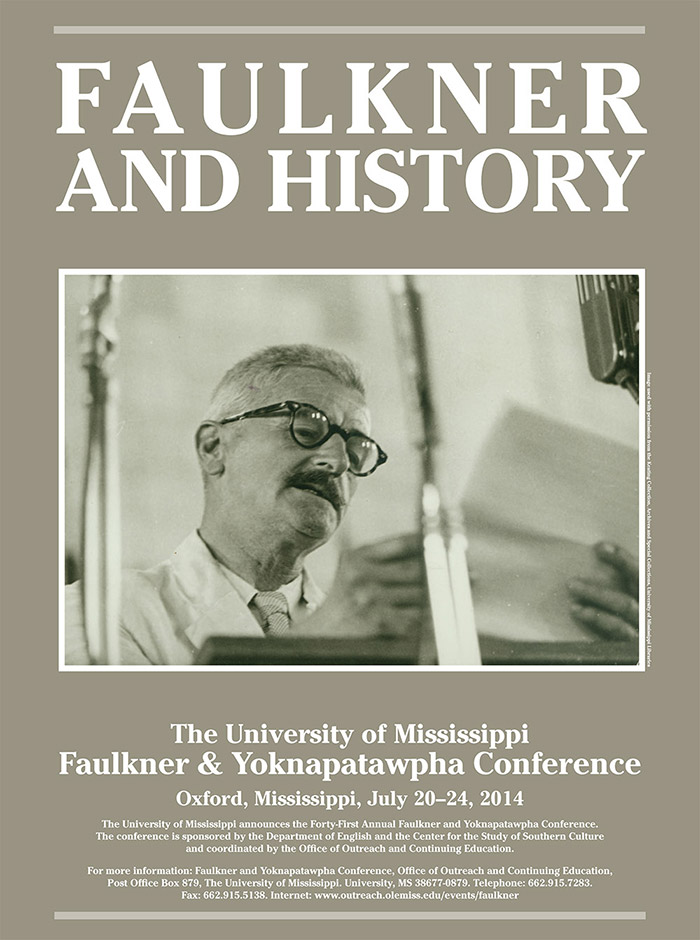
Panel. Deciphering Sutpen's Hundred: Ideology, Representation, and the Politics of Aesthetics in Absalom, Absalom!
Location
Yerby Center Auditorium
Start Date
23-7-2014 3:30 PM
Description
- "The Tamer's Lash": Thomas Sutpen as Monstrous Ur-Planter in Faulkner's Absalom, Absalom! / Josh Jones, Fordham University
Against interpretations of Thomas Sutpen in Faulkner’s Absalom, Absalom! as an interloper and upstart in the planter class of the Deep South, this paper argues that he is in fact an exemplary member. Sutpen’s violence represents the counter-revolutionary violence of the South in securing property and labor, suppressing dissent, and realizing imperial designs. His crude methods shock only those members of the community who, like Rosa Coldfield, accept the artificial decorum of the South as its true face. This essay also examines the ways that Sutpen’s origin story, as concocted by Rosa, Quentin, Shreve, and Jason Compson, present us with a narrative of the origins of Deep South in general, with its contradictory ethos of ignorance and cunning and sense of nationhood built on white supremacy and a Lockean doctrine of private property that grants landowners special status and excludes the propertyless from full participation in the social order. - Sutpen's Egalitarian Design and Faulkner's Ironic Allegory in Absalom, Absalom! / Jennifer Gilchrist
This paper situates Faulkner 1936 High Modernist masterpiece in relation to the progressive zeitgeist of its era, exemplified by the influential League of American Writers. In this reading, Sutpen’s design and its disastrous but well-intentioned effects constitute an ironic allegory of the social/literary egalitarian fervor of the Depression. Employing recent literary historical scholarship of the American Left and close readings of the text, Gilchrist hopes to recover the driving irony in the novel’s internal logic--which would have been easier to detect at its publication--and to expand our understanding of Absalom! Absalom!’s initial cultural interventions and stakes. - Home and the Expansion of Geographic Scale in Sutpen's Hundred / Mark Sursavage, University of Houston
Examining the representation of “home” in Absalom, Absalom!, this presentation argues that the narrative structure is the nexus between the novel’s depiction of space and its own classification as a transnational text. Neil Smith’s understanding of geographical scale provides a framework through which to examine the production of space as a vision unique to a particular text. As such, Sutpen’s Hundred becomes the primary space within Faulkner’s novel where the scale of home is contested, the point of negotiation between Thomas Sutpen and the community of Jefferson. The novel’s narrative structure similarly becomes a reader’s means of negotiation between various points of view, the key to identifying the novel’s resonance within its own spatial frameworks of the South and the globe. This presentation posits the importance of geographical scale as a way to understand not only the space within a novel, but also the literary spaces that determine its reception.
Relational Format
Conference proceeding
Recommended Citation
Jones, Josh; Gilchrist, Jennifer; and Sursavage, Mark, "Panel. Deciphering Sutpen's Hundred: Ideology, Representation, and the Politics of Aesthetics in Absalom, Absalom!" (2014). Faulkner and Yoknapatawpha Conference. 28.
https://egrove.olemiss.edu/fy/2014/schedule/28
COinS
Jul 23rd, 3:30 PM
Panel. Deciphering Sutpen's Hundred: Ideology, Representation, and the Politics of Aesthetics in Absalom, Absalom!
Yerby Center Auditorium
- "The Tamer's Lash": Thomas Sutpen as Monstrous Ur-Planter in Faulkner's Absalom, Absalom! / Josh Jones, Fordham University
Against interpretations of Thomas Sutpen in Faulkner’s Absalom, Absalom! as an interloper and upstart in the planter class of the Deep South, this paper argues that he is in fact an exemplary member. Sutpen’s violence represents the counter-revolutionary violence of the South in securing property and labor, suppressing dissent, and realizing imperial designs. His crude methods shock only those members of the community who, like Rosa Coldfield, accept the artificial decorum of the South as its true face. This essay also examines the ways that Sutpen’s origin story, as concocted by Rosa, Quentin, Shreve, and Jason Compson, present us with a narrative of the origins of Deep South in general, with its contradictory ethos of ignorance and cunning and sense of nationhood built on white supremacy and a Lockean doctrine of private property that grants landowners special status and excludes the propertyless from full participation in the social order. - Sutpen's Egalitarian Design and Faulkner's Ironic Allegory in Absalom, Absalom! / Jennifer Gilchrist
This paper situates Faulkner 1936 High Modernist masterpiece in relation to the progressive zeitgeist of its era, exemplified by the influential League of American Writers. In this reading, Sutpen’s design and its disastrous but well-intentioned effects constitute an ironic allegory of the social/literary egalitarian fervor of the Depression. Employing recent literary historical scholarship of the American Left and close readings of the text, Gilchrist hopes to recover the driving irony in the novel’s internal logic--which would have been easier to detect at its publication--and to expand our understanding of Absalom! Absalom!’s initial cultural interventions and stakes. - Home and the Expansion of Geographic Scale in Sutpen's Hundred / Mark Sursavage, University of Houston
Examining the representation of “home” in Absalom, Absalom!, this presentation argues that the narrative structure is the nexus between the novel’s depiction of space and its own classification as a transnational text. Neil Smith’s understanding of geographical scale provides a framework through which to examine the production of space as a vision unique to a particular text. As such, Sutpen’s Hundred becomes the primary space within Faulkner’s novel where the scale of home is contested, the point of negotiation between Thomas Sutpen and the community of Jefferson. The novel’s narrative structure similarly becomes a reader’s means of negotiation between various points of view, the key to identifying the novel’s resonance within its own spatial frameworks of the South and the globe. This presentation posits the importance of geographical scale as a way to understand not only the space within a novel, but also the literary spaces that determine its reception.

